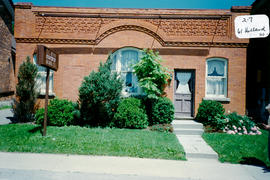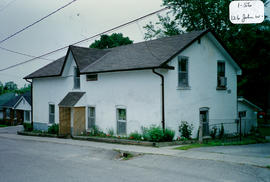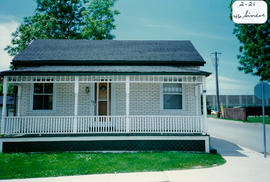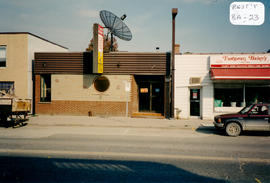61 Holland Street West - D.G. Bevan Insurance/ Scanlon Law Offices
- CA BWGPL GJ-HB-2017-03-29-07
- Item
- 1996
Part of George Jackson fonds
The building located on the north side at 61 Holland St. West was built in the Romanesque Revival style around the 1880’s. The Scanlon Law Offices building was originally constructed to house the law practice of the two Scanlon brothers. Albert "Ab" Scanlon, a lawyer, and Mrs. Frank (Ethel) Woods, a widow and retired farmer (from the 8th Line) both resided here at one time.
The one-storey building has a rectangular plan, small window openings with high floor to ceiling heights, and a flat roof. The symmetrical façade has a simple, solid form. Round arches are reminiscent of the Roman Empire and rich, decorative details. Originally, there were two entrances contained unobtrusively in simple, rectangular openings on either side of the centre window. This is atypical of the Romanesque Revival style, where the entrance door was more frequently the most prominent element of the façade. The second entrance door to the west of the centre window has been “bricked in”, but its flat, arch opening is still visible by the line of the brick voussoirs. There is a wood-panelled door with an upper, glass light and also a rear entrance. The centre, ground-floor window is a prominent feature. It is exaggerated by the arch form set into the parapet above and subdivided vertically into three parts. Smaller windows to each side are set into segmented, arch openings with brick voussoirs. The windows are double-hung with stone (or concrete) lug sills. A major feature is the heavy parapet with an insert panel decorated richly with brick set in a basket weave pattern. The segmented arch extends the window form into the parapet panel. A cornice line along the bottom of the parapet is decorated with a line of brick dentils. The building has masonry construction, brick cladding, and a cut-stone foundation. According to the 2000 inventory, the structure is in good condition with many, original details remaining. (1, 2, 3)
George Jackson










